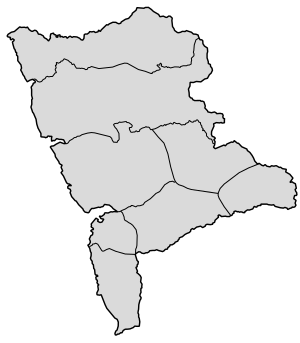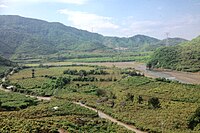Shizi (Pingtung)
|
Shizi 獅子 鄉 |
||
 Location Shizis in Pingtung County |
||
| State : |
|
|
| County : | Pinging | |
| Coordinates : | 22 ° 16 ' N , 120 ° 44' E | |
| Area : | 301.0018 km² | |
| Residents : | 5,019 (Sep 2018) | |
| Population density : | 17 inhabitants per km² | |
| Time zone : | UTC + 8 (Chungyuan time) | |
| Telephone code : | (+886) (0) 8 | |
| Postal code : | 943 | |
| ISO 3166-2 : | TW-PIF | |
| Community type : | Rural community (鄉, Xiāng) | |
| Structure : | 8 villages (村, Cūn ) | |
| Mayor : | Wu Qinglong ( 伍慶隆 ) | |
| Website : | ||
|
|
||
Shizi ( Chinese 獅子鄉 , Pinyin Shīzǐ Xiang , Paiwan : Sisigu ) is a rural municipality in Pingtung County on Taiwan ( Republic of China ).
location
Shizi is located near the southern tip of the island of Taiwan, south of the Tropic of Capricorn . Most of the municipality is located in the central Taiwanese mountains . In terms of area, it is the largest municipality in Pingtung County. However, the population density is very low with 16 inhabitants per km². The terrain is steep and mountainous and the climate in the valleys is tropical, hot and relatively dry. Autumn and winter are characterized by monsoon winds ( fall winds ). At higher altitudes, temperatures are more moderate and winters are rainy. The two main rivers are the Lushan ( 枋山 ) and the Fenggang ( 楓 港 溪 ), both of which flow in an east-west direction and are the main sources of drinking water.
The neighboring communities are Chunri in the north, Fangshan in the west, Checheng and Mudan in the south and Daren in the west (in neighboring Taitung County ). Shizi is inland, but in sections it is barely 100 meters away from the coast through the narrow coastal strip of the municipality of Fangshan.
history
The name 獅子 , Shīzǐ means " lion ". According to tradition, the name of the eponymous village 獅子 村 is derived from a rock, the shape of which is reminiscent of a lion's head (similar to the Lion Rock in Hong Kong ). The original inhabitants of the area were Austronesian ethnic groups, who still make up the majority today. The immigration of Han Chinese , which began in the 17th century, remained limited due to the inaccessible location and the relatively barren soil. Shizi Rural Community was established as an administrative unit in September 1951 shortly after Pingtung County was established.
population
According to official statistics, at the end of 2017 4587 people (around 92%) belonged to the indigenous peoples. Most of the time it was Paiwan .
| Outline Shizis |
Administrative division
Shizi is divided into 8 villages (names in the Paiwan language, in Chinese script and transcription).
- Nanesiku ( 南 世 村 , Nanshi)
- Kacedas ( 內 獅 村 , Neishi)
- Sisetu ( 獅子 村 , Shizi)
- Supaw ( 草埔 村 , Caobu)
- Naibun ( 內 文 村 , Neiwen)
- Butangelu ( 丹 路 村 , Danlu)
- Kaidi ( 楓林 村 , Fenglin)
- Tjuruquay ( 竹 坑村 , Zhukeng)
traffic
Provincial road 1 runs in north-south direction directly on the west coast, still in the neighboring community of Fangshan. The southern end point is the eponymous village of Fangshan. To the south of it the road continues as Provincial Road 26. Just before the crossing, the Provincial Road 9 branches off and runs essentially parallel to the course of the Fengang River inland towards the east. It later turns into Provincial Road 9e (9 戊 ), which leads to Daren in neighboring Taitung County.
The southern connecting line ( 南 迴 線 , Nánhuí Xiàn ) of the Taiwanese Railway with the terminus in Taitung City and Fangliao Municipality runs through Shizi . In Shizi there is a regular Fangshan train station (near the border to the neighboring community of the same name, but still in the community area of Shizi - Taiwan's southernmost train station), as well as two stations in Fangye ( 枋 野 ) and at the west portal of the Central tunnel that provides the rail link to the neighboring community of Daren.
Agricultural products
The country is relatively barren and there are nationally important agricultural products only in the two villages of Supaw / Caobu and Naibun / Neiwen, which are located at an altitude of over 500 meters. Local agricultural products are mangoes , nest fern ( 山 蘇 , Shānsũ ; a vegetable) and watermelons.
Attractions
Shizi is not very well developed for tourism. The tropical nature is particularly worth seeing. These include the Shuangliu Forest Recreation Area ( 雙流 國家 森林 遊樂 區 ). or the Kayoufeng waterfall ( 卡 悠 峯 瀑布 ).
Every five years, the main Paiwan festival, Mateveq , takes place in October .
Web links
Individual evidence
- ↑ a b 地理 環境 ("Geographical Environment"). Shizi's website, accessed November 3, 2018 (Chinese).
- ↑ 關於 獅子 ("About Shizi"). Shizi's website, accessed November 3, 2018 (Chinese).
- ↑ 原住民 戶數 及 人數 Households and Persons of Indigenous People. (xls) Ministry of Interior of Taiwan, accessed November 3, 2018 (Chinese, English).
- ↑ 農 特 產品 ("Agricultural Products"). Shizi's website, accessed November 3, 2018 (Chinese).
- ^ Shuangliu National Forest Recreation Area. Coa. Taiwan, December 8, 2016, accessed November 3, 2018 (English, advertising film about the nature park).
- ↑ 2017 06 24 日 屏東 獅子 鄉 卡 悠 峰 瀑布 (June 24, 2017: Kayoufeng waterfall in Shizi (Pingtung)). YouTube video of a hike, accessed November 3, 2018 .
- ↑ 歷史 傳說 ("Historical Legends"). Shizi's website, accessed November 3, 2018 (Chinese).




